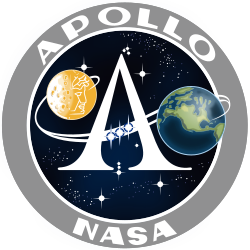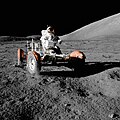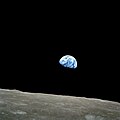Apollo program
The Apollo program (or Project Apollo) was a project by the United States' National Aeronautics and Space Administration (NASA). The program was named after the Greek god Apollo. The goal was to send a human to explore the Moon and bring him home to earth safely. It was started by US President John F. Kennedy in 1961. He said:
Now it is time to take longer strides - time for a great new American enterprise - time for this nation to take a clearly leading role in space achievement, which in many ways may hold the key to our future on Earth.
...I believe that this nation should commit itself to achieving the goal, before this decade is out, of landing a man on the Moon and returning him safely to the Earth. No single space project in this period will be more impressive to mankind, or more important in the long-range exploration of space; and none will be so difficult or expensive to accomplish.[1] Full text
One reason the program started was that the Soviet Union was the first country to send a person into outer space. Since this was during the Cold War, many in the US thought that the US needed to stay ahead of the USSR in space exploration.
The Apollo spacecraft was made up of a Command and Service Module, and a Lunar Module. The Command Module was a space capsule. The Lunar Module was a lander. These spacecraft docked on the way to the Moon. Mercury and Gemini spaceships were very small and cramped, but the Apollo capsule was much bigger. Astronauts could move around and not have to stay in their seats. The Lunar Lander was also big on the inside. The only part of the Apollo spacecraft to come back to Earth was the capsule, the Lunar Module would crash on the moon.
The Apollo program ended in 1975. After that, NASA began to work on the Space Shuttle program, the International Space Station, and many unmanned space exploration projects.
There was a movie made about the problems that happened on the Apollo 13 mission.
Missions
In September 1967, Owen Maynard of the Manned Spacecraft Center in Houston, Texas proposed a series of Apollo missions that would lead to landing a person on the Moon.[2] There were seven types of mission, each testing a specific set of parts and tasks. Each step would need to be completed successfully before the next mission type could begin.[3] These were:
- A - Unmanned Saturn V and Command/Service Module (CSM) development (Apollo 4, Apollo 6)
- B - Unmanned Lunar Module (LM) development (Apollo 5)
- C - Manned CSM evaluation in low Earth orbit (Apollo 7)
- D - Manned CSM and LM development in low Earth orbit (originally planned for Apollo 8; flown as Apollo 9)
- E - Manned CSM and LM operations, a practice lunar mission in a medium Earth orbit with an apogee of 4600 mi (7400 km), but never flew
- F - Manned CSM and LM operations in lunar orbit, a "dress rehearsal" for the first landing (Apollo 10)
- G - First manned lunar landing (Apollo 11)
The first manned Lunar Module, LM-3, was not ready for the December 1968 launch date of Apollo 8. The mission flew as a lunar orbital mission, using just the CSM. The E mission was canceled.
The first landing would be followed by more advanced lunar missions:
- H - precision landings with up to two-day stays on the Moon, with two lunar Extra-Vehicular Activities or "moonwalks" (Apollo 12, Apollo 13 (planned), Apollo 14)
- I - long duration CSM lunar orbital surveys using a Scientific Instrument Module mounted in an empty Service Module bay. These were added into the J missions.
- J - longer three-day stays using an Extended LM, with three LEVAs and a Lunar Roving Vehicle (Apollo 15, Apollo 16, Apollo 17). Apollo 18 to 20 would have been J missions. Apollo 15 was originally an H mission but was changed to J as the program was cut short.
Apollo flights
The Apollo flights were carried into space by the Saturn I and V rockets.[4]
Uncrewed
- AS-101 was launched on May 28, 1964. The flight was designed to test the Command Module.
- AS-102 was launched on September 18, 1964. The flight was designed to test the Command Module.
- AS-103 was launched on February 16, 1965. The flight was designed to test the Command Module. It also carried a Pegasus satellite.
- AS-104 was launched on May 25, 1965. The flight was designed to test the Command Module. It also carried a Pegasus satellite.
- AS-105 was launched on July 30, 1965. The flight was designed to test the Command Module. It also carried a Pegasus satellite.
- AS-201 was launched on February 26, 1966. The flight was designed to test the Command Module.
- AS-202 was launched on August 25, 1966. The flight was designed to test the Command Module.
- Apollo 4 was launched on November 9, 1967. The flight was designed to test the Command Module.
- Apollo 5 was launched on January 22, 1968. The flight was designed to test the Lunar Module.
- Apollo 6 was launched on April 4, 1968. The flight was the last flight to check all the systems.
Crewed
- Apollo 1 caught fire during pre-flight training on January 27, 1967, killing three astronauts: Edward White, Gus Grissom, and Roger Chaffee.
- Apollo 7 was launched on October 11, 1968. This was the first flight with a crew, Wally Schirra, Donn Eisele, and Walter Cunningham. The flight, which orbited the Earth for several days, tested the command Module.
- Apollo 8 was launched December 21, 1968. The crew, Frank Borman, Jim Lovell, and William Anders, were the first astronauts to go into orbit around the Moon.
- Apollo 9 was launched March 9, 1969. The crew, James McDivitt, David Scott, and Russell Schweickart, tested the Lunar Module in orbit around the Earth and practiced docking with the Command Module.
- Apollo 10 was launched on May 18, 1969. This was the first complete Apollo rocket carrying all the equipment. The crew, Thomas Stafford, John Young, and Eugene Cernan, studied possible landing sites while in orbit around the Moon.
- Apollo 11 was launched on July 16, 1969. This was the first spacecraft to land on the Moon with astronauts Neil Armstrong and Buzz Aldrin on July 20, 1969. Michael Collins was in control of the Command Module which stayed in orbit around the moon.
- Apollo 12 was launched on November 14, 1969. The crew Pete Conrad and Alan Bean were the second team to land on the Moon on November 19, 1969. They collected moon rocks and examined the Surveyor 3 spacecraft that had landed on the Moon in 1967. Richard Gordon stayed in the Command Module
- Apollo 13 was launched on April 11, 1970. An explosion in one of the oxygen tanks nearly caused the death of the three astronauts, Jim Lovell, Jack Swigert, and Fred Haise. Emergency repairs were made and they were able to return safely to Earth.
- Apollo 14 was launched on January 31, 1971. On February 5, 1971 astronauts Alan Shepard and Edgar Mitchell became the third group to land on the Moon. They collected rocks and carried out experiments while Stuart Roosa stayed in orbit in the Command Module.
- Apollo 15 was launched on July 26, 1971. It continued the collecting and experiments of earlier landings. David Scott and James Irwin landed on the Moon on July 30, 1971, while Alfred Worden stayed in orbit.
- Apollo 16 was launched on April 16, 1972. John Young and Charles Duke landed on the Moon on April 21, 1972, while Ken Mattingly stayed in orbit.
- Apollo 17 was launched on December 7, 1972. This was the final Moon visit, landing on December 11, 1972, and was the first to take a scientist, Harrison Schmitt with astronaut Eugene Cernan. Ronald Evans stayed in orbit.
- Skylab 2 was launched on May 25, 1973. Pete Conrad, Paul Weitz and Joseph Kerwin were the first crew of the Skylab space station.
- Skylab 3 was launched on July 28, 1973. Alan Bean, Jack Lousma and Owen Garriott were the crew of the Skylab space station.
- Skylab 4 was launched on November 16, 1973. Gerald Carr, William Pogue and Edward Gibson were the last crew of the Skylab space station.
- Apollo-Soyuz was launched on July 15, 1975. It was the last mission of Apollo.
Apollo ProgramMissions Media
Buzz Aldrin (pictured) walked on the Moon with Neil Armstrong, on Apollo 11, July 20–21, 1969.
NASA Apollo 17 Lunar Roving Vehicle
Earthrise, the iconic 1968 image from Apollo 8 taken by astronaut William Anders
President Kennedy speaks at Rice University, September 12, 1962 (17 min, 47 s).
George Mueller, Wernher von Braun, and Eberhard Rees watch the AS-101 launch from the firing room.
John Houbolt explaining the LOR concept
Early Apollo configuration for Direct Ascent and Earth Orbit Rendezvous, 1961
An Apollo boilerplate command module is on exhibit in the Meteor Crater Visitor Center in Winslow, Arizona.
Neil Armstrong pilots the Apollo Lunar Module Eagle and lands himself and navigator Buzz Aldrin on the Moon, July 20, 1969.
The Journeys of Apollo, a NASA documentary about the Apollo program
Related pages
References
- ↑ Kennedy, John F. (May 25, 1961). Special Message to Congress on Urgent National Needs (Motion picture (excerpt)). Boston, MA: John F. Kennedy Presidential Library and Museum. Accession Number: TNC:200; Digital Identifier: TNC-200-2. Retrieved August 1, 2013.
- ↑ Murray, Charles, and Catherine Bly Cox. Apollo: The Race to the Moon. New York: Simon and Schuster, 1989. pp. 315-316.
- ↑ "Part 2(D) - July through September 1967". The Apollo Spacecraft — A Chronology. Volume IV. NASA. 1975. Archived from the original on 2008-02-05. Retrieved 2008-01-29.
- ↑ "Apollo Program". burro.astr.cwru.edu. 2006. Archived from the original on January 4, 2013. Retrieved August 10, 2012.










